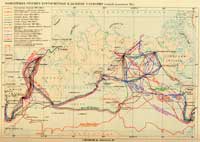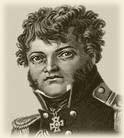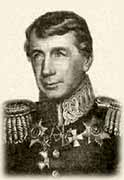§ Russia
The first Russian round-the-world voyage
on the ships “Neva” and “Nadejda”
The history of the first half of the XIX century witnessed a number of the outstanding geographic discoveries. Russian round-the-world voyages were the most prominent among them.
The Russia of the XIX century took a leading place in the organizing of round-the world voyages and ocean exploration.

The first voyage of Russian ships around the world under the command of Captain-Lieutenants I. F. Krusenstern and Y. Lisyansky had lasted three years, like most such trips of that time.
The trip in 1803 was the starting point which began a whole epoch of remarkable Russian round-the world voyages.
Y. F. Lisyansky received an order to go to England to buy two ships for a round-the world-voyage. Lisyansky bought two ships — the Nadejda and the Neva for 22,000 pounds, which was equal to the same sum in golden roubles according to the rate at that time.

Actually the deal for the ships equaled to 17,000 pounds, but the correction work required additional 5,000 pounds.
The Nadejda had been sailing for 3 years since she had been launched; the Neva had been launched only 15 months. The Neva was a vessel of 350 tons displacement, the Nadejda — 450 tons.
In England Lisyansky bought a number of sextants, mariner’s compasses, barometers, hygrometers, a few thermometers, one artificial magnet, chronometers made by Arnold and Pettington and other things. The chronometers were examined and tested by an academician Schubert. Trouton made all the other instruments.
 The astronomical and physical instruments were earmarked for observation of longitude and latitude to define the location of the ship. Lisyansky took care to have a good stock of medicine, including pills to treat scurvy. The latter was one of the most dangerous diseases during long trips. In England they also bought the necessary equipment for the expedition, including the clothes for the crew, which could suit to different climatic conditions. They also had a large stock of linen and sea uniform. The mattresses, pillows, sheets and warm blankets had been bought for every seaman. Sea provision was one of the best. The slices of dried bread (’sukhary’), prepared in St.-Petersburg, had remained in good condition for two years. The same goes for salted meat (“solonina”), which had been salted by Russian salt by merchant Oblomkov. The Nadejda’s crew consisted from 58 men, the Neva’s — 47. The crews were made up from sailors-volunteers, who applied for the round-the-world trip in great numbers: one could even make up a few crews for several expeditions. One should remember that there were no crew members who would have participated in distant trips since at that time Russian ships didn’t sail to the south of North tropic. The task, which the officers and the crew of the expedition faced, was not an easy one. They were to cross two oceans, pass by a dangerous cape Horn, notorious by the storms, go on upwards up to 60 degrees of the north longitude, and visit a number of poorly known shores, which could have surprised the seamen with unexpected underwater reefs and other dangerous things. But the commanding officers who supervised the expedition were so sure in “officers and sailors’ staff”, that wouldn’t take a few foreign sailors, who had been familiar with conditions of distant trips. However there were foreign natural scientists on board the ship: Tilezius-fon-Tilenau, Langsdorf, and an astronomer Gorner. The latter came from Switzerland. Gorner had been working in a then famous Zee berg observatory and his supervisor recommended him to Count Rumyantsev. There was also an artist from the Academy of Arts in the expedition.
The astronomical and physical instruments were earmarked for observation of longitude and latitude to define the location of the ship. Lisyansky took care to have a good stock of medicine, including pills to treat scurvy. The latter was one of the most dangerous diseases during long trips. In England they also bought the necessary equipment for the expedition, including the clothes for the crew, which could suit to different climatic conditions. They also had a large stock of linen and sea uniform. The mattresses, pillows, sheets and warm blankets had been bought for every seaman. Sea provision was one of the best. The slices of dried bread (’sukhary’), prepared in St.-Petersburg, had remained in good condition for two years. The same goes for salted meat (“solonina”), which had been salted by Russian salt by merchant Oblomkov. The Nadejda’s crew consisted from 58 men, the Neva’s — 47. The crews were made up from sailors-volunteers, who applied for the round-the-world trip in great numbers: one could even make up a few crews for several expeditions. One should remember that there were no crew members who would have participated in distant trips since at that time Russian ships didn’t sail to the south of North tropic. The task, which the officers and the crew of the expedition faced, was not an easy one. They were to cross two oceans, pass by a dangerous cape Horn, notorious by the storms, go on upwards up to 60 degrees of the north longitude, and visit a number of poorly known shores, which could have surprised the seamen with unexpected underwater reefs and other dangerous things. But the commanding officers who supervised the expedition were so sure in “officers and sailors’ staff”, that wouldn’t take a few foreign sailors, who had been familiar with conditions of distant trips. However there were foreign natural scientists on board the ship: Tilezius-fon-Tilenau, Langsdorf, and an astronomer Gorner. The latter came from Switzerland. Gorner had been working in a then famous Zee berg observatory and his supervisor recommended him to Count Rumyantsev. There was also an artist from the Academy of Arts in the expedition.
 An artist and scientists were staying together with N. Rezanov, the Russian envoy and plenipotentiary to Japan, and his retinue on board of a big ship the Hope, which was under the command of Kruzenshtern. Lisyansky was entrusted the command of the Neva.
Though Kruzenshtern was listed the commander of the Hope and chief of the expedition on sea in the Navel Ministry, but in the instruction, which had been sent by Alexander I to the Russian Ambassador to Japan N. Rezanov, the latter was identified the Chief of the Expedition. This duality/duplicity of the situation accounted for the conflict in relations between Rezanov and Kruzenshtern. So Kruzenshtern repeatedly approached the Management of the Russian-American company, where he wrote that he had been called on by His Imperial Majesty to be in command of the expedition and that “it had been entrusteded to Rezanov” without his knowledge, and that he would never have agreed that his responsibilities “would consist of looking for sails”, etc. Soon the relations between Rezanov and Kruzenshtern grew so unbearable that the riot had broken up among the crew of the Hope.
An artist and scientists were staying together with N. Rezanov, the Russian envoy and plenipotentiary to Japan, and his retinue on board of a big ship the Hope, which was under the command of Kruzenshtern. Lisyansky was entrusted the command of the Neva.
Though Kruzenshtern was listed the commander of the Hope and chief of the expedition on sea in the Navel Ministry, but in the instruction, which had been sent by Alexander I to the Russian Ambassador to Japan N. Rezanov, the latter was identified the Chief of the Expedition. This duality/duplicity of the situation accounted for the conflict in relations between Rezanov and Kruzenshtern. So Kruzenshtern repeatedly approached the Management of the Russian-American company, where he wrote that he had been called on by His Imperial Majesty to be in command of the expedition and that “it had been entrusteded to Rezanov” without his knowledge, and that he would never have agreed that his responsibilities “would consist of looking for sails”, etc. Soon the relations between Rezanov and Kruzenshtern grew so unbearable that the riot had broken up among the crew of the Hope.
The Russian envoy to Japan, N. Rezanov, after a string of troubles and insults, was forced to stay in his cabin which he wouldn’t leave until the Hope arrived in Petropavlovsk-on-Kamchatka. Here Rezanov approached the Major-General Koshelev, a representative of local administrative authorities. As a result the conflict has put Kruzenshtern in a disadvantage and he considering the given situation, publicly apologized to Rezanov and asked Koshelev not to proceed with the further investigation. Only due to the courtesy of Rezanov, who decided to stop the inquest, Kruzenshtern had avoided more troubles, which could have had the fatal consequences for his career.
The given episode shows that the discipline on the Hope, which was under command of Kruzenshtern, was not on the high level if N. Rezanov, a statesman of the highest rank and plenipotentiary, the envoy to Japan could be subjected to a number of insults inflicted by a few members of the crew and the captain of the Hope. The circumstance that “Hope” during its sail had experienced very risky situations several times was not probably accidental, while the Neva had only once sat on a coral reef and in a such place, where it was impossible to expect it on the maps. All this points to a suggestion that a common belief about the leading role of Kruzenshtern in the first Russian round-the-world trip does not correspond to reality.
Though the first part of the trip to England, and then through the Atlantic ocean in pass-by of a cape Horn the ships were to make together, but then near the Sandvich Islands (the Hawaiian Islands) they were be continue on their own. The Hope, according to the plan of the expedition was to sail on to Kamchatka, where she was to leave her cargo. Then Kruzenshtern was to go on to Japan and deliver there the Russian plenipotentiary and envoy N. Rezanov with his retinue. After that the Hope was once again to return to Kamchatka, take the cargo of fur and take it to Canton for sale. Starting from the Hawaiian Islands, the way the Neva passed was absolutely different. Lisyansky was to sail northwest, to the island Kadiyak, where the Headquarters of the Russian-American company was located at that time. They were planning for the Hope to stay there through the winter and then she was to take the cargo of fur and deliver it in Canton, where the meeting of both ships the Neva and the Hope was due to take place. From Canton both ships were to make way to Russia past the cape of Good Hope. This plan was realized though with a few alterations, caused by storms, which parted the ships, as well as long-lasting calls at the ports to do necessary repairs and renewing of provisions.
The natural scientists, staying on the ships, have collected valuable botanical, zoological and ethnographic collections. They carried out the observations of sea currents, temperature and density of water in deep waters up to 400 m, tides, low tides and fluctuations a barometer. They conducted systematic astronomical observations to determine of longitude and latitude and has put down on the map the coordinates of a number of places, which they had visited, including all ports and islands, where they called at.
Even though special tasks of expedition in Russian colonies had been successfully executed, one couldn’t say the same about the part of the expedition plan, which was connected with organization of the embassy in Japan. The N. Rezanov embassy was not a success. Though he was surrounded by attention and all the signs of respect were displayed to N. Rezanov on his arrival to Japan, but he didn’t manage to establish trade relations with this country.
On the 5th of August, 1806 the Neva successfully arrived in Kronshtadtsky roadstead. The cannon salute from the Neva rang out and the Kronshtadtskaya fortress shots rang out in return. Thus, the Neva had been staying in expedition for three years and two months. On the 19th of August the Nadejda, which had been staying in a round-the-world trip by fourteen days longer, than the Neva, also reached the Kronshtadtsky roadstead.
The first Russian round-the-world trip had made up the epoch in the history of Russian fleet and delivered the world geographical science new information about poorly explored countries. A number of of islands, which were visitted Lisyansky and Kruzenshtern, had been recently discovered by seafarers before them, and the nature of these islands, their population and customs remained nearly absolutely unknown. The Sandvich (Hawaiian) Islands were ones of them. They were discovered in 1778 by Cook, less than thirty years before they were visit by Russian sailors. Russian travelliers could observe the life of inhabitants in its natural condition, which had not been changed yet by the influence of European culture. Markizskie and Vashingtonovy islands, as well as Paskhi island (Easter island ) had been poorly studied so far. Therefore it was not surprising that the descriptions of the Russian round-the-world journey, made by Kruzenshtern and Lisyansky, had a lot of readers get interested in them and were translated in several foreign languages. Materials, collected during the trip of the Neva and the Hope, presented a great value for study of the primitive nations, inhabitting Okeania islands and the north part of the Pacific ocean. Our first Russian travellers observed these people in the stage of generic relations. It was the first time when they had described in detail the unique ancient hawaiian culture with its immutable laws “taboo” and human sacrifices. Rich ethnographic collections, brought by the Neva and the Hope, together with the descriptions of customs, beliefs and even the language of the inhabitants of the Pacific Ocean, had served the valuable sources for study of the nations inhabitting islands of the Pacific Ocean.
Thus, the first Russian round-the-world journey has played a great role in the development of ethnography. One can attribute it for a big keenness of observation and accuracy of descriptions of our first round-the-world travelliers.
It must be pointed out that that multiple observations of sea currents, temperature and water density, which were carried out on the Neva and Nadejda had given a push to the development of new science — oceanography. Before the first russian round-the-world journey such systematic observations by seafarers hadn’t been carried out. Russian sailors turned out to be the greater innovators in this respect.
The first Russian round-the-world trip opens the epoch of brilliant round-the-world journeyes, conducted under the Russian flag.
During these trips there was created the beautiful staff of sailors, which have gained experience in prolonged trips to far countries and high qualification in a complex for boat fleet art of navigation.
 It is interesting to mention the fact that one of the participants of the first Russian round-the-world trip Kotsebu, who had been sailing as a cadet on the Hope, subsequently carried out a more interesting round-the-world trip on the Ryurik, equipped on money provided by Count Rumyantsev.
It is interesting to mention the fact that one of the participants of the first Russian round-the-world trip Kotsebu, who had been sailing as a cadet on the Hope, subsequently carried out a more interesting round-the-world trip on the Ryurik, equipped on money provided by Count Rumyantsev.
The expedition conducted by the Neva and the Hope layed the route of a new way into the Russian North American colonies. Since then the necessary provisions and goods had been shipped there by a sea way. These constant long trips have increased colonial trade and in many ways promoted the development of north American colonies and Kamchatka.
The overseas trade has developed, Russia’s relations with countries of the Pacific Ocean have also been growing. The first Russian round-the-world journey has layed down a strong scientific base for a difficult art of distant navigation by a number of valuable observations along the route of far sea trips.
Materials on the topic
| |























